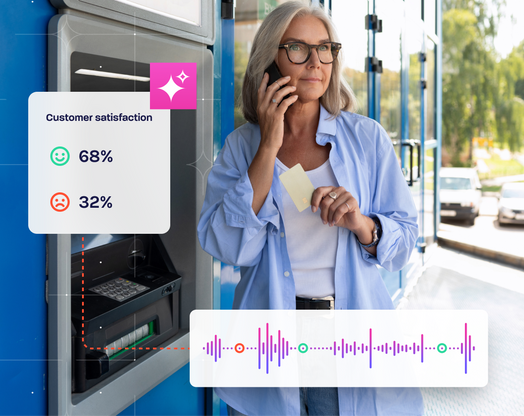
Digital Transformation in Financial Services | Glassbox
Cash, cards and even a branch visit are rapidly giving way to taps, swipes and seamless in-app journeys. For financial services professionals, this shift isn’t a trend—it’s a watershed moment where digital technology is transforming how customers interact with banks, insurers and other financial institutions. Institutions that embrace this transformation gain loyalty, efficiency and market share, while those that hesitate risk falling behind.
But why is digital transformation so important right now? Customers demand frictionless and personalized experiences, regulators require transparency and compliance and agile fintech companies are setting new standards for innovation. Add the need to cut costs and improve agility, and the pressure for change becomes undeniable.
In this blog, we’ll explore the forces driving this shift, the technologies powering innovation and how financial institutions can overcome common roadblocks to deliver smarter, faster and more secure experiences across every channel.
What Is Digital Transformation in Financial Services?
Digital transformation in financial services refers to integrating new technologies to modernize operations, enhance customer experience and meet compliance requirements. More than just adopting digital tools, it’s about rethinking systems, services and experiences through a digital-first lens.
This transformation impacts both internal operations and external customer interactions:
Internal Impacts
Automating underwriting, claims processing and loan approvals with AI
Breaking down departmental silos through real-time data sharing
Migrating to scalable cloud-based infrastructures
Embedding compliance controls into workflows to meet evolving regulatory standards
External Impacts
Simplifying customer onboarding with biometric verification and digital Know Your Customer (KYC)
Delivering personalized financial products based on behavioral analytics
Providing consistent service across digital channels like mobile banking apps and branch kiosks
Resolving disputes faster with complete visibility into customer journeys
Why Digital Transformation is Critical for Financial Institutions
Today’s customers demand instant transactions, personalized services and airtight security. Meeting these expectations requires advanced digital capabilities. Yet many financial institutions struggle with legacy systems that slow innovation and increase operational risks.
Four key drivers push financial services companies to prioritize transformation:
Customer Expectations: Consumers compare digital banking experiences to the best in e-commerce, demanding speed, simplicity and personalization.
Competitive Pressure: Fintech companies and challenger banks innovate rapidly, forcing traditional banks to keep pace.
Regulatory Demands: Compliance frameworks like GDPR and PSD2 require transparent, auditable processes that manual systems can’t deliver.
Agility and Resilience: Institutions need systems that adapt quickly to economic change and cybersecurity threats.
Embracing these drivers delivers measurable results. According to Boston Consulting Group, digitally mature banks could collectively grow revenues by $100 billion annually. Glassbox helps financial services organizations achieve these outcomes with advanced analytics that expose friction points and improve customer journeys.
For the financial services industry, a successful digital transformation brings tangible results, including:
Higher customer satisfaction scores from personalized, seamless interactions
Reduced churn rates through improved engagement and faster issue resolution
New revenue streams through embedded finance and API-driven models
Lower cost-to-income ratios by automating manual processes
And for financial services organizations looking to lead, the transformation must be ongoing, data-driven and built around real-time visibility into every digital interaction.
Glassbox helps financial institutions realize these benefits with tagless data capture, session replay and AI-powered insights.
The 4 Main Areas of Digital Transformation
Digital transformation in financial services is reshaping the foundation of how institutions operate, serve customers and compete in the market.
While it touches every part of the organization, meaningful progress often begins in four core areas: customer experience, operational processes, business models and organizational culture.
1. Customer Experience
In the banking sector, the quality of your customer experience is a competitive differentiator. Customers expect digital banking that is fast, intuitive and personalized, across every touchpoint.
Top-performing financial institutions invest in:
Seamless mobile banking and web journeys that eliminate friction during tasks like balance checks, transfers or loan applications
AI-powered personalization that aligns financial products with real-time customer data
Omnichannel support that connects experiences across apps, kiosks and in-person interactions
Glassbox enables this by capturing and analyzing 100% of user interactions—without requiring manual tagging.
2. Operational Processes
A successful digital transformation initiative also targets what’s behind the scenes. Financial institutions are modernizing legacy systems to create faster, leaner operations.
Key areas of focus include:
Automating repetitive workflows like compliance reporting and onboarding
Using machine learning to detect fraud and improve risk scoring
Streamlining financial data sharing across departments to reduce resolution times and improve customer engagement
Glassbox complements these efforts by capturing customer interactions and revealing inefficiencies, enabling continuous improvement.
3. Business Models
Digital transformation in the financial services industry is also unlocking new business models and revenue streams. Whether it’s open banking, embedded finance or subscription-based tools, institutions are rethinking how, where and when services are delivered.
That’s why innovative banks are:
Extending their reach through API ecosystems
Partnering with fintechs to offer financial services in non-traditional channels
Creating value through real-time updates and hyper-relevant offers
Glassbox helps optimize these experiences with journey analytics and funnel analysis that reveal drop-off points and quantify revenue impact.
4. Organizational Culture
Transformation doesn’t succeed without a culture that supports it. In the financial services sector, forward-thinking institutions are building teams that can move fast, think critically and embrace emerging technologies.
Cultural enablers include:
A digital-first mindset that supports continuous improvement
Cross-functional teams that collaborate on digital initiatives
Upskilling programs focused on data analytics, cybersecurity and digital strategy
Glassbox supports this culture by providing actionable insights that align product, compliance and IT teams around shared goals.
These four areas lay a foundation for success. When each area advances in sync, the entire institution gains speed, agility and measurable ROI.
Technologies Driving Digital Transformation in Finance
Several technologies are reshaping the financial services sector. These innovations power faster, more secure and more personalized services.
AI & Machine Learning: Predictive analytics, fraud detection and personalized recommendations drive customer engagement and risk management.
Automation & RPA: Robotic process automation accelerates manual workflows like compliance reporting.
Open Banking & APIs: APIs enable secure data sharing with third-party apps, expanding service offerings.
Blockchain: Distributed ledgers improve transparency and security in cross-border payments and smart contracts.
Cloud Platforms & Cybersecurity: Scalable infrastructure supports innovation while protecting sensitive financial data.
Glassbox integrates seamlessly with these technologies, providing real-time insights that help financial services companies refine digital strategies.
Discover how analytics can improve customer engagement
Future Trends in Financial Services Digital Transformation
Emerging trends redefine how financial services companies interact with customers:
Embedded Finance: Payments and loans integrate directly into non-financial platforms like e-commerce sites.
Hyper-Personalization: AI delivers tailored offers based on real-time data.
Predictive CX: Machine learning anticipates customer needs and prevents frustration before it escalates.
Cross-Channel Analytics: Consistent experiences across apps, kiosks and wearable devices build customer trust.
Glassbox equips financial institutions to stay ahead of these trends with real-time insights and advanced analytics.
Learn more about Gen Z’s expectations for seamless journeys: Gen Z Insights
Ready to Future-Proof Your Digital Transformation Strategy?
Digital transformation is the key to stronger customer relationships, higher efficiency and sustained growth. Glassbox helps financial services companies capture actionable insights, improve customer journeys and meet compliance standards.
Take the next step. Tour Glassbox to see how our platform can elevate your digital strategy.







